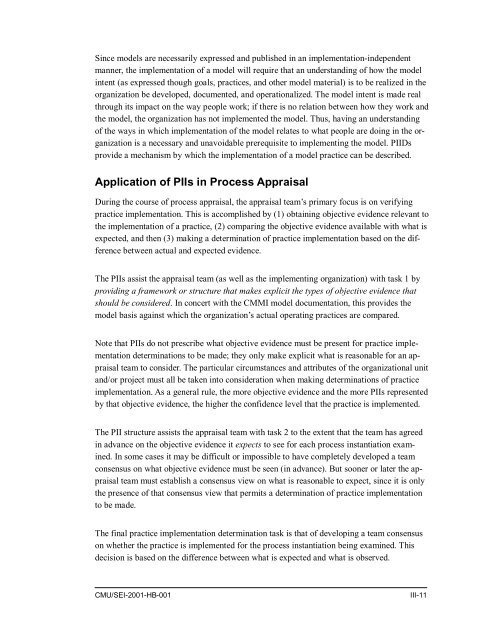Standard CMMI Appraisal Method for Process Improvement (SCAMPI)
Standard CMMI Appraisal Method for Process Improvement (SCAMPI)
Standard CMMI Appraisal Method for Process Improvement (SCAMPI)
Create successful ePaper yourself
Turn your PDF publications into a flip-book with our unique Google optimized e-Paper software.
Since models are necessarily expressed and published in an implementation-independent<br />
manner, the implementation of a model will require that an understanding of how the model<br />
intent (as expressed though goals, practices, and other model material) is to be realized in the<br />
organization be developed, documented, and operationalized. The model intent is made real<br />
through its impact on the way people work; if there is no relation between how they work and<br />
the model, the organization has not implemented the model. Thus, having an understanding<br />
of the ways in which implementation of the model relates to what people are doing in the organization<br />
is a necessary and unavoidable prerequisite to implementing the model. PIIDs<br />
provide a mechanism by which the implementation of a model practice can be described.<br />
Application of PIIs in <strong>Process</strong> <strong>Appraisal</strong><br />
During the course of process appraisal, the appraisal team’s primary focus is on verifying<br />
practice implementation. This is accomplished by (1) obtaining objective evidence relevant to<br />
the implementation of a practice, (2) comparing the objective evidence available with what is<br />
expected, and then (3) making a determination of practice implementation based on the difference<br />
between actual and expected evidence.<br />
The PIIs assist the appraisal team (as well as the implementing organization) with task 1 by<br />
providing a framework or structure that makes explicit the types of objective evidence that<br />
should be considered. In concert with the <strong>CMMI</strong> model documentation, this provides the<br />
model basis against which the organization’s actual operating practices are compared.<br />
Note that PIIs do not prescribe what objective evidence must be present <strong>for</strong> practice implementation<br />
determinations to be made; they only make explicit what is reasonable <strong>for</strong> an appraisal<br />
team to consider. The particular circumstances and attributes of the organizational unit<br />
and/or project must all be taken into consideration when making determinations of practice<br />
implementation. As a general rule, the more objective evidence and the more PIIs represented<br />
by that objective evidence, the higher the confidence level that the practice is implemented.<br />
The PII structure assists the appraisal team with task 2 to the extent that the team has agreed<br />
in advance on the objective evidence it expects to see <strong>for</strong> each process instantiation examined.<br />
In some cases it may be difficult or impossible to have completely developed a team<br />
consensus on what objective evidence must be seen (in advance). But sooner or later the appraisal<br />
team must establish a consensus view on what is reasonable to expect, since it is only<br />
the presence of that consensus view that permits a determination of practice implementation<br />
to be made.<br />
The final practice implementation determination task is that of developing a team consensus<br />
on whether the practice is implemented <strong>for</strong> the process instantiation being examined. This<br />
decision is based on the difference between what is expected and what is observed.<br />
CMU/SEI-2001-HB-001<br />
III-11
















